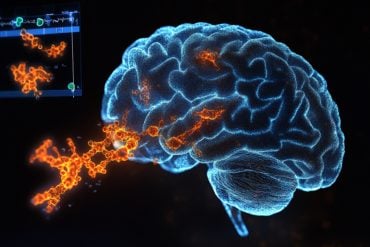Summary: Optogenetic stimulation causes signals in the sensory cortex to halt actions during a behavioral task, while altering signals in the motor cortex to cause mice to act more impulsively.
Source: Rutgers University
Learning how to tie a shoe or shoot a basketball isn’t easy, but the brain somehow integrates sensory signals that are critical to coordinating movements so you can get it right.
Now, Rutgers scientists have discovered that sensory signals in the brain’s cerebral cortex, which plays a key role in controlling movement and other functions, have a different pattern of connections between nerve cells and different effects on behavior than motor signals. The motor area of the cortex sends signals to stimulate muscles.
The research on neural signals, published in the journal Current Biology, could help lead to new treatments for movement disorders such as Parkinson’s disease and Huntington’s disease or psychiatric conditions such as obsessive compulsive disorder.
Scientists at Rutgers University-New Brunswick and Rutgers-Newark investigated a brain region called the striatum in mice. The striatum, which integrates signals from the sensory and motor areas of the cerebral cortex, is severely compromised in diseases such as Parkinson’s and Huntington’s.
“We found that stimulation of sensory cortex signals caused mice to stop their actions during a behavioral task, but motor cortex signals caused them to perform the task more impulsively,” said senior author David J. Margolis, an assistant professor in the Department of Cell Biology and Neuroscience in the School of Arts and Sciences at Rutgers-New Brunswick.

Future research will investigate the patterns of signaling between the cerebral cortex and striatum during different types of learning paradigms in mice to understand nerve cell connection mechanisms. The ultimate goal is to understand how abnormal cortex-striatum signaling is involved in neurological and psychiatric disorders.
The lead author is Christian R. Lee in the Department of Cell Biology and Neuroscience. Co-authors include Alex J. Yonk, Joost Wiskerke and Kenneth G. Paradiso in that department and James M. Tepper, a Distinguished Professor in the Center for Molecular and Behavioral Neuroscience at Rutgers-Newark.
Funding: The research was funded by the Rutgers Brain Health Institute Pilot Grant Program, National Institutes of Health and National Science Foundation.
Source:
Rutgers University
Media Contacts:
Todd Bates – Rutgers University
Image Source:
The image is credited to Alex Yonk.
Original Research: Open access.
“Opposing Influence of Sensory and Motor Cortical Input on Striatal Circuitry and Choice Behavior”
Christian R. Lee, Alex J. Yonk, Joost Wiskerke, Kenneth G. Paradiso, James M. Tepper, David J. Margolis. Current Biology doi:10.1016/j.cub.2019.03.028
Abstract
Opposing Influence of Sensory and Motor Cortical Input on Striatal Circuitry and Choice Behavior
Highlights
• S1 provides stronger input to striatal PV neurons than spiny projection neurons
• M1 provides equal input to striatal PV neurons and spiny projections neurons
• S1- and M1-corticostriatal inputs exert opposing influence on choice behavior
• Manipulation of striatal PV neurons bidirectionally influences choice behavior
Summary
The striatum is the main input nucleus of the basal ganglia and is a key site of sensorimotor integration. While the striatum receives extensive excitatory afferents from the cerebral cortex, the influence of different cortical areas on striatal circuitry and behavior is unknown. Here, we find that corticostriatal inputs from whisker-related primary somatosensory (S1) and motor (M1) cortex differentially innervate projection neurons and interneurons in the dorsal striatum and exert opposing effects on sensory-guided behavior. Optogenetic stimulation of S1-corticostriatal afferents in ex vivo recordings produced larger postsynaptic potentials in striatal parvalbumin (PV)-expressing interneurons than D1- or D2-expressing spiny projection neurons (SPNs), an effect not observed for M1-corticostriatal afferents. Critically, in vivo optogenetic stimulation of S1-corticostriatal afferents produced task-specific behavioral inhibition, which was bidirectionally modulated by striatal PV interneurons. Optogenetic stimulation of M1 afferents produced the opposite behavioral effect. Thus, our results suggest opposing roles for sensory and motor cortex in behavioral choice via distinct influences on striatal circuitry.






